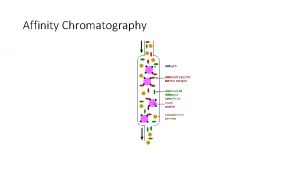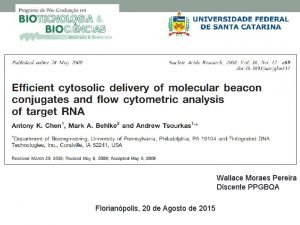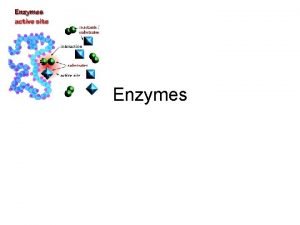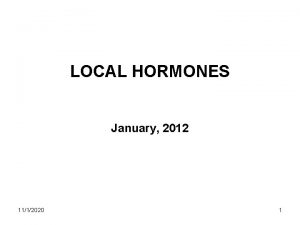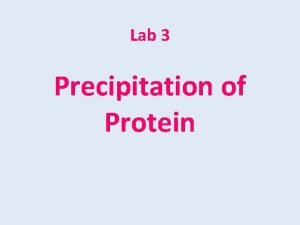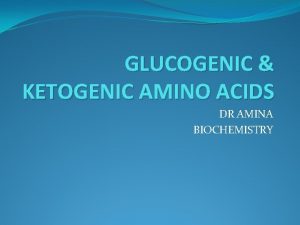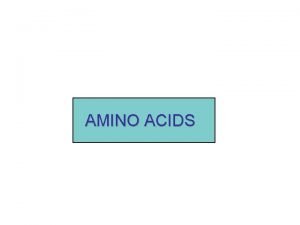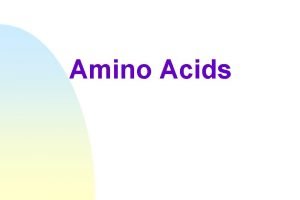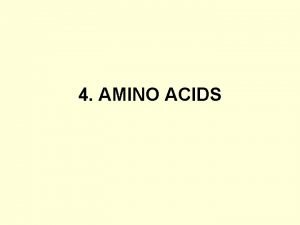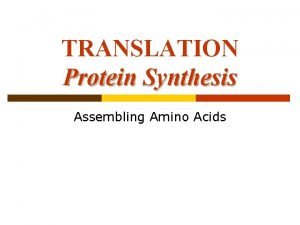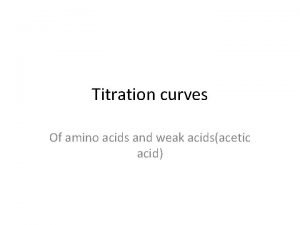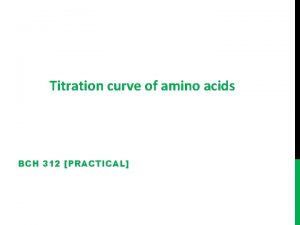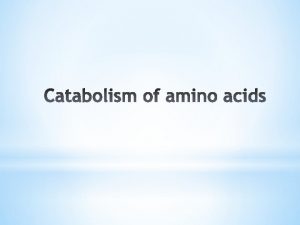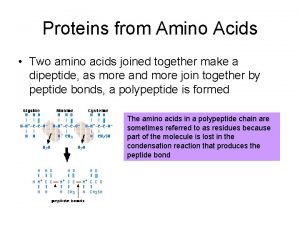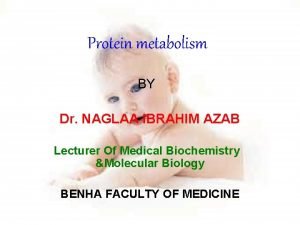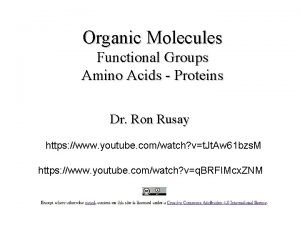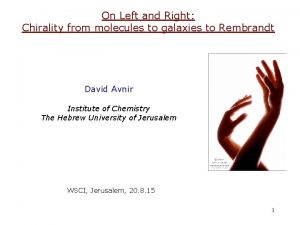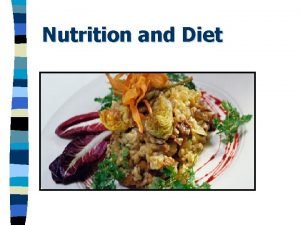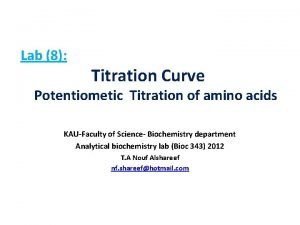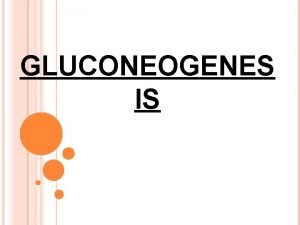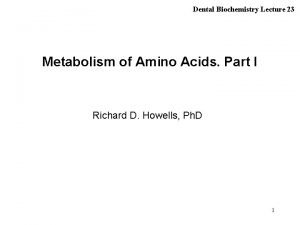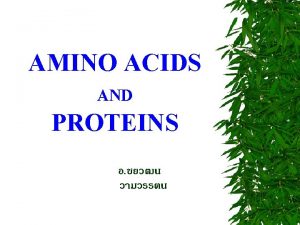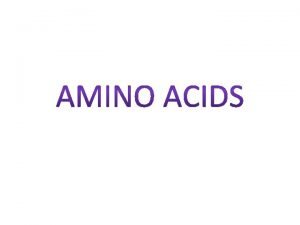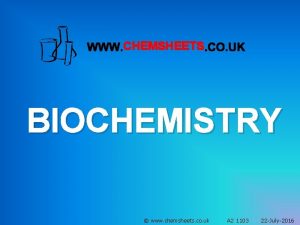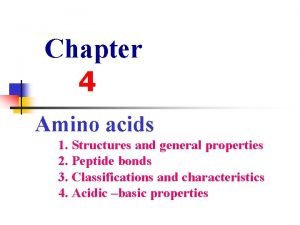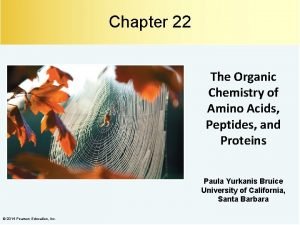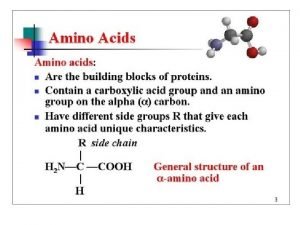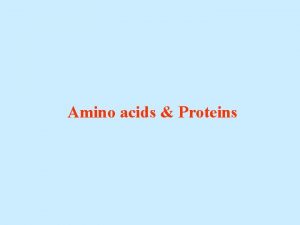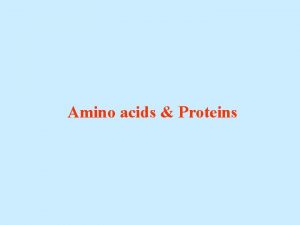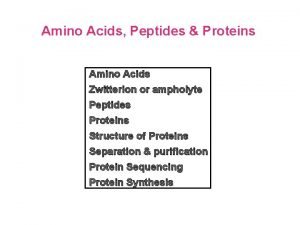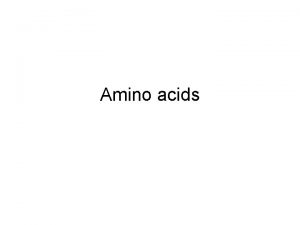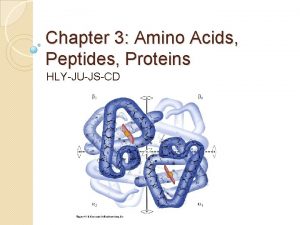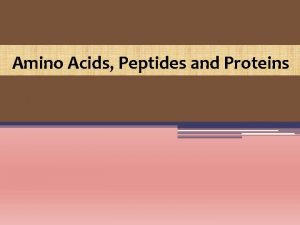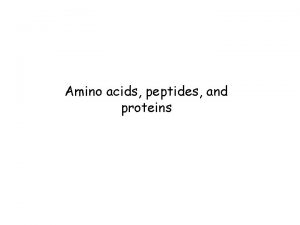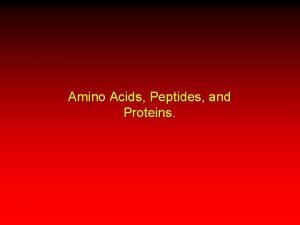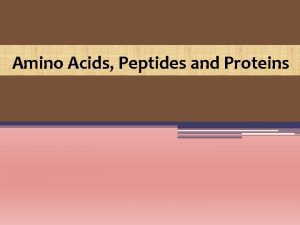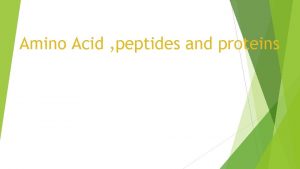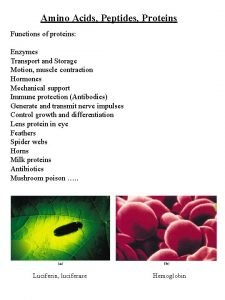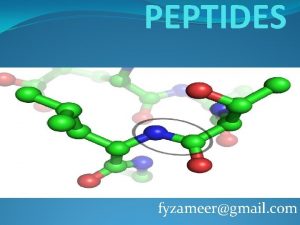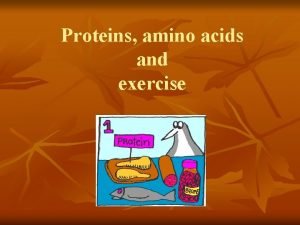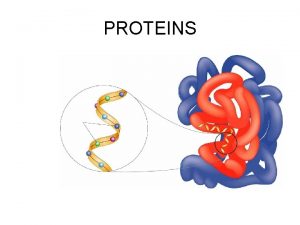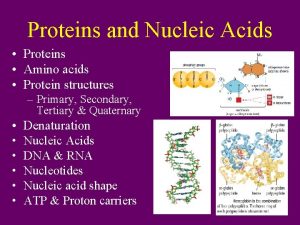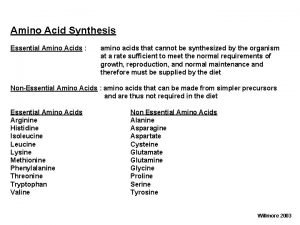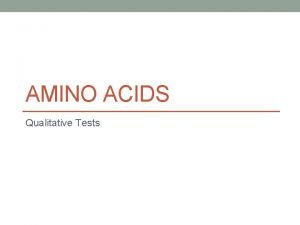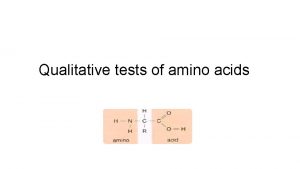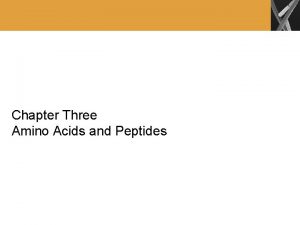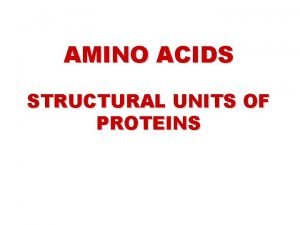Chapter 3 Amino Acids Peptides and Proteins Amino



























- Slides: 27

Chapter 3 Amino Acids, Peptides, and Proteins

Amino Acids

Amino Acids n 20 Residues n Numbering of carbons § 1, 2, 3. . . from C of COO§ a , b, g… from C bonded to NH 3+ and COO- n Absolute configuration of amino acids § L amino acids in biological system 1 2 a

Classification of Amino Acids Nonpolar UV absorption at 280 nm

Classification of Amino Acids • Nonpolar • Structural role

Classification of Amino Acids

Uncommon Amino Acids n Collagen n Myosin n Cell wall n Collagen n Prothrombin n Ca 2+ binding proteins n Elastin n A few proteins n Incorporation during translation

Amino Acids as Acids and Bases n Zwitterion § Acts as either an acid or a base § Ampholytes § Amphoteric substances § Substances with dual nature n Amino acid is a diprotic acid

Titration of Amino Acids n Two p. Ka and two buffering regions n p. I: ioselectric point or isoelectric p. H § The point with zero electric charge § Above p. I : negative charge § Below p. I : positive charge n p. I = (p. K 1 + p. K 2)/2 = 5. 92

Effect of Chemical Environment on p. Ka

Amino Acids with Ionizable R Group n p. I = (p. K 1 + p. KR)/2 = 3. 22 n p. I = (p. KR+ p. K 2)/2 = 7. 59

Peptides and Proteins

Peptides and Proteins n Peptide bond § Dehydration reaction n Polypeptide vs. protein § Polypeptide: Mr<10, 000 n Amino-terminal (N-terminal) n Carboxyl-terminal (C-terminal)

Ionization of Peptide n Ionization of peptide § One free a-amino group § One free a-carboxyl group § Inonizable R groups n p. Ka of R groups in peptide § Different from p. Ka of free amino acid

Biologically Active Peptides and Polypeptides n Size § Small peptide § Vertebrate hormones § § Oxytocin (9), thyrotropin-releasing factor (3), insulin (30 + 21) Antibiotics § Large proteins § Most of the proteins § Titin: vertebrate muscle protein (27, 000 a. a. ) § < 2, 000 a. a. n Oligomeric status § Single polypeptide chain § Multisubunit proteins § Oligomeric : at least two subunits are identical § Protomers : identical units n Calculation of the number of amino acid residues § Mr / 110 § Average Mr of 20 a. a. : 138 § Average Mr of protein a. a : 128 § Removal of water during peptide bond formation : 128 -18 =110

Conjugated Proteins n Conjugated proteins § Proteins with permanently associated chemical components § Prosthetic group § Non-amino acid part of a conjugated protein

Working with Proteins

Protein Purification n Cell lysis § Crude extract n Fractionation § Use differences in protein solubility § Depending on p. H, temperature, § salt concentration etc. Salting out § Addition of ammonium sulfate ((NH 4)2 SO 4) for differential precipitation of proteins n Dialysis § Exchange of salts and buffer using semipermeable membrane n Column chromatography § Separation of proteins based on charge, size, binding affinity etc. § Stationary phase and mobile phase containing protein

Ion-exchange chromatography n Cation-exchange chromatography § Solid matrix : negatively charged group § Positive charged proteins migrate slowly n Anion-exchange chromatography § Solid matrix : positively charged group

Size-Exclusion Chromatography n Solid matrix : Beads with engineered pores of cavities n Small proteins enter the pores § Slow migration

Affinity Chromatography n Beads with covalently attached chemical group § Binding of proteins with affinity for the chemical group

Protein Purification n HPLC (high-performance liquid chromatography) § Use high pressure pump that speed the movement of the protein molecules § Limited diffusion High resolution n Determining the methods for protein purification § Mostly empirical

Separation of Protein by Electrophoresis n Electrophoresis § Separation of charged proteins in an electric field § Electrophoretic mobility of proteins § Depending on size and shape of proteins n SDS gel electrophoresis (SDS PAGE) § SDS (sodium dodecyl sulfate) binds to proteins roughly proportional to the molecular weight of the protein § Binding of 1 SDS/ 2 amino acids § § § Similar chare to mass ratio for all the proteins § Similar shape for all the proteins Separation of proteins depending on the mass § Useful to determine molecular weight Visualization of the bands by staining (e. g. Goomassie blue)

Determining Molecular Weight of a Protein SDS PAGE (polyacrylamide gel electrophoresis)

Isoelectric Focusing n Procedure to determine the p. I of a protein § Establishment of p. H gradient § Gel containing a mixture of low molecular weight organic acids and bases (ampholytes) § Application of electric field § Each protein migrates until it reaches the p. H corresponding to its p. I

Two-Dimensional Electrophoresis § 1 o : Isoelectric focusing § 2 o : SDS-PAGE

Quantification of Proteins During the Purification n Enzyme assay § 1 unit of enzyme activity § The amount of enzymeo causing transformation of 1. 0 mmol of substrate/min at 25 C under optimal conditions § Activity § Total units of enzyme in solution § Decrease during purification § Specific activity § The number of enzyme units/ mg of total proteins § Measure of enzyme purity § Increase during purification n Other assays § Biological activities § DNA binding, alteration of cell growth § Detection of the presence of the target protein § Western blotting
 Amidomalonate synthesis mechanism
Amidomalonate synthesis mechanism Affinity chromatography principle
Affinity chromatography principle Amino acids are joined together in proteins by
Amino acids are joined together in proteins by Ppgbqa
Ppgbqa Image
Image Local hormone
Local hormone Precipitation of proteins by strong mineral acids
Precipitation of proteins by strong mineral acids Ketogenic amino acid
Ketogenic amino acid Arginine essential
Arginine essential Ketogenic amino acid
Ketogenic amino acid Difference between hydrophobic and hydrophilic amino acids
Difference between hydrophobic and hydrophilic amino acids Dehydration synthesis of amino acids
Dehydration synthesis of amino acids Amino acids titration curves
Amino acids titration curves Titration curve of amino acids
Titration curve of amino acids Deamination of amino acids
Deamination of amino acids 2 amino acids joined together
2 amino acids joined together Oxidative deamination of amino acids
Oxidative deamination of amino acids Amino acids groups
Amino acids groups Right handed amino acids
Right handed amino acids Carbohydrates gives
Carbohydrates gives Glycine titration curve
Glycine titration curve Gluconeogenes
Gluconeogenes Glutamate oxidative deamination
Glutamate oxidative deamination What is the r group in amino acids
What is the r group in amino acids Amino acids are classified as
Amino acids are classified as Chemsheets amino acids
Chemsheets amino acids Optical properties of amino acids
Optical properties of amino acids ε-amino
ε-amino

